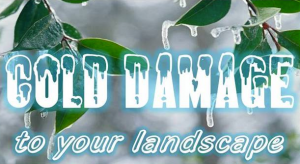
During the cold, frost and freezing months of winter grass goes into a dormant stage. It stops growing and relies on the starch stored in its root system to survive. While the grass may appear dead and need little attention it also is the time when your lawn is the most vulnerable to damage.
When the grass blades freeze they become brittle. The grass blades can snap off like broken sticks when walked upon. This is not harmful if only the top of the grass is snapped but unfortunately when you walk on the lawn during this time you can crush the grass crown.
The crown is the life center of grass growth. It is the thick, whitish part of the grass that grows along the top of the soil. This is the birthing point for all new grass growth. While it is safe to cut the top of the grass as we do when mowing and it quickly recovers the same cannot be said for damaging the grass crowns.
Damaged and crushed crowns will not survive. This is why it is important not to drive on the lawn during the cold months unless a thick layer of snow has piled up providing cushioning. If the lawn is simply frozen but not snow covered even walking across it can be harmful.
Another thing that can be harmful to lawns is shoveling snow onto the lawn in heavy piles. Snow that falls naturally is not dense and compacted as packed shoveled snow can be. While some of this cannot be helped it is a good idea if you can to throw the snow as far as you can and disperse it at different levels.
And be careful about building Frosty the snowman! Yep, good, old Frosty can be a hazard if built too big and solid and left on the lawn for a long period of time. The light and fluffy white stuff that falls from the heavens gets very heavy when molded into big round balls. The weighted, compacted snow pushes down hard on the soil and packs it down. This compaction makes it difficult for the organisms in the soil to survive. When the organisms cannot breathe, drink or eat they will die as well.
I’m not suggesting kids should not have the fun of building snowmen. But it might be a good idea when Frosty starts to melt to break up the snow balls and disperse some of that weight around. Compacted soil is not a good thing. The only organisms that seem to thrive well with it are weeds! Hard, compacted earth is the leading cause for weed growth.
One more Jack Frost tip before I end this bit of winter lawn gloom. Snow Mold. This is a fungal disease that can occur when the snow melts or from constant cold, wet moisture such as fog. It is not common and usually happens on weak or new lawns that have not built up healthy crown and root systems. Lawns that were fertilized heavily with nitrogen too close to the freeze period are especially vulnerable to this disease. It is also a cause of compacted snow. Keep Frosty to a medium size and break him up when he starts to become an ice chunk and all should be well!
Thanks to Grassstitcher.com for these words of advice.
